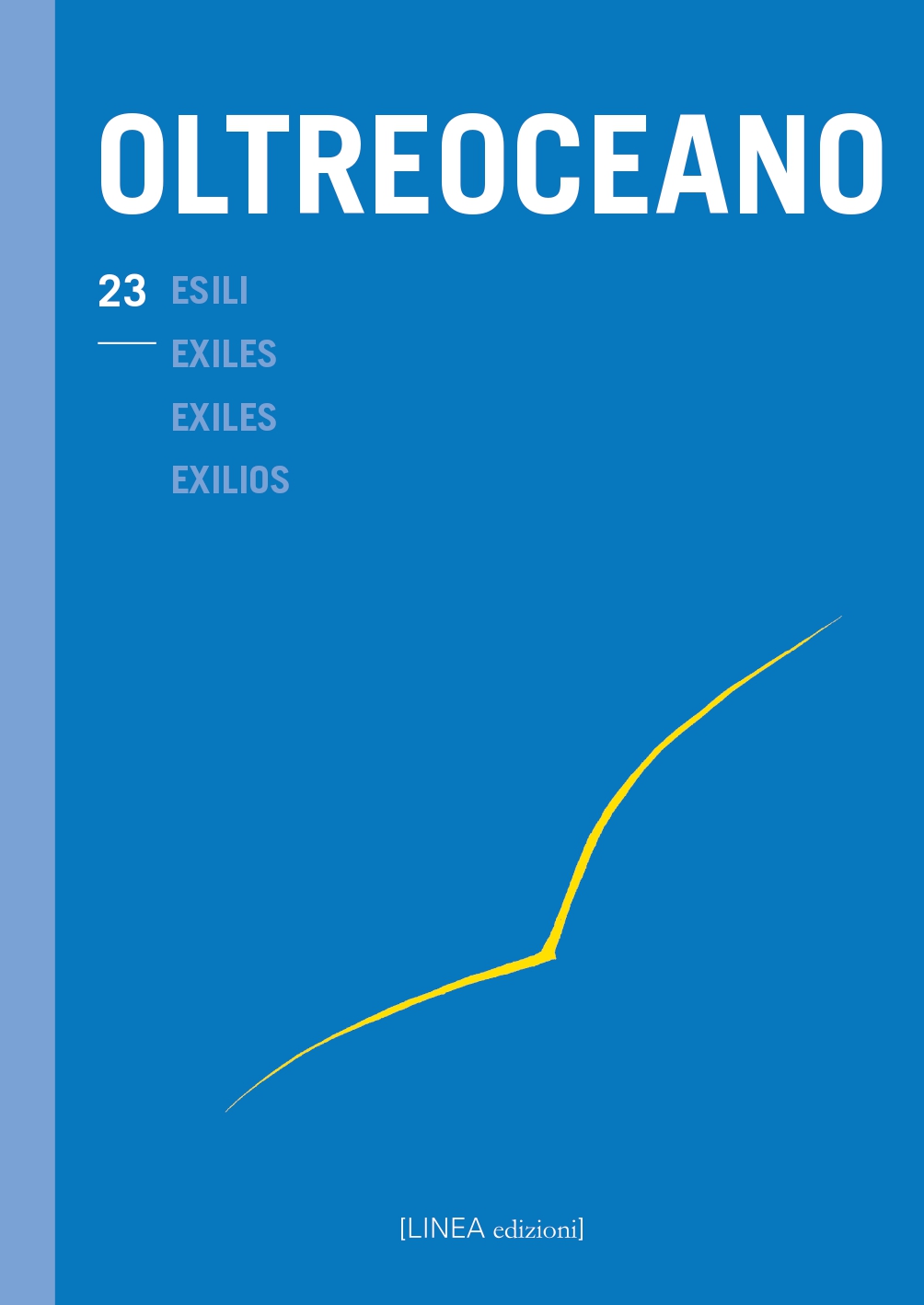Ryoko Sekiguchi: Exile Between Simultaneity and Superimposition
DOI:
https://doi.org/10.53154/Oltreoceano105Keywords:
Simultaneity, Superposition, Ryoko Sekiguchi, Poetry, ExileAbstract
In an interview, Ryoko Sekiguchi remarked about her experience of exile: "exiled people always live two seasons simultaneously" (2021). This means, for example, that in winter she can live with the sky of Tokyo, Beirut or Granada, while being in Paris. This imaginative ubiquity of presence is not only at the center of her condition as a foreigner in France, but also at the heart of her poetic work, involving space-times characterized by a principle of simultaneity and by the constant attempt to superimpose several texts or several voices on the same sensitive surface. In this study, we analyze the role played by simultaneity and superimposition as poetic and heuristic tools in the poet's work. Among the works that make up his vast corpus, we have chosen to focus on Heliotropes. This book seems particularly significant to us, since it bases the simultaneity of all its constituent elements on the superposition between the poetic world and the world of plants. After briefly presenting the text, we explore the superposition between textual forms and plant forms in order to identify the principles of spatialization that allow Sekiguchi to neutralize time: we first look at the isomorphy between metric block and botanical block, because the measure chosen by the author is based on a principle of crystallization that leaves no room for random proliferation and reminds us, on the one hand, the geometric principles governing the formation of the regular and symmetrical structures of plants, and on the other, the desire for order that allows nature to be landscaped as a garden. Then, we examine the analogy between the forms of textual grafting and the so-called plant grafts. We thus wish to reconstruct the movements and space-times of this writing of exile which is configured as the simultaneous listening of multiple sounds.
Downloads
References
Bailey, L. H. (1963): How Plants get their Names. New York: Dover Publications.
Benjamin, W. (1920): La tâche du traducteur. In Walter Benjamin, Œuvres. 1971. Paris: Gallimard.
Briot, F. (2015): Ryoko Sekiguchi: ubiquités mineures, polychronies épidémiques. In Jean-Christophe DelMeule, Apparition Disparition Réapparition. La tortue verte. Revue en ligne des littératures francophones. Tiré de http://www.latortueverte.com/Apparition%20Disparition%20Reapparition%20%20juillet%202015%20la%20TortueVerte.pdf (Consulté le 02/03/2024).
Costa, E. (2015): A Tale of Two Tongues: Self-Translation in Sekiguchi Ryōko’s Poetry. Contemporary Japan, 27, pp.111-130.
Derrida, J. (1972a): La Dissémination. Paris: Seuil.
Derrida, J. (1972b): Marges de la philosophie. Paris: Minuit.
Doppelt, S. & Sekiguchi, R. (2005): Anthropomagie. Cristallisation du sel. Vacarme, 30, pp. 88-89.
Elhariry, Y. (2017): Pacifist Invasions: Arabic, Translation & the Postfrancophone Lyric. Liverpool: Liverpool University Press.
Folkart, B. (1991): Le Conflit des énonciations. Traduction et discours rapporté. Québec: Balzac.
Heller-Roazen, D. (2006): Parler en langues. T. Samoyault (Trad.). Po&sie, 117-118, pp. 122-139.
Littré, É. (1877): Histoire naturelle de Pline: avec la traduction en français, 2. Paris: Firmin-Didot.
Mairesse, A. (2010): Ryoko Sekiguchi, au “marché” de l’échange poétique. In M. Dambre & R. J. Golsan (Éds.), L’exception et la France contemporaine: Histoire, imaginaire, littérature. Paris: Presses de la Sorbonne Nouvelle: 193-202. Tiré de https://books.openedition.org/psn/345 (Consulté le 04/ 03/2024).
Sekiguchi, R. (2001): Calque. Paris: P.O.L.
Sekiguchi, R. (2004): Nettai shokubutsuen. Tokyo: Shoshi Yamada.
Sekiguchi, R. (2003): Traduire les noms propres. Vacarme, 25, pp. 96-98.
Sekiguchi, R. (2005): Héliotropes. Paris: P.O.L.
Sekiguchi, R. (2016): Écrire double. Tiré de http://remue.net/Ecrire-double-Ryoko-Sekiguchi (Consulté le 20/04/2024).
Sekiguchi, R. (2021): Podcast “à quoi pensez-vous” d’Arnaud Laporte, 21 janvier 2021. Tiré de https://www.radiofrance.fr/franceculture/podcasts/a-quoi-pensez-vous/ryoko-sekiguchi-les-personnes-exilees-vivent-toujours-deux-saisons-simultanement-5818788 (Consulté le 02/04/2024).
Stétiéh, S. (2010): L’ornement, lieu spirituel de l’islam. Conférence donnée lors du Colloque international Vers en images: l’iconographie de la poésie occidentale (manuscrits enluminés, imprimés illustrés, livres de dialogue), Rouen, 14-16 octobre 2010. Tiré de https://salahstetie.net/?p=114 (Consulté le 10/03/2024).
Szendy, P. (2001): Écoute. Une histoire de nos oreilles. Paris: Minuit.
Downloads
Published
How to Cite
Issue
Section
License

This work is licensed under a Creative Commons Attribution-NonCommercial-ShareAlike 4.0 International License.
The authors undertake to comply with the following conditions, which are considered accepted at the time of submission of their contributions.
The sending of a text implies that it is unpublished and not submitted to be published elsewhere.
1. If accepted, the author shall confer on the publisher the right to publish and distribute it both in paper form and in the online electronic edition. The published articles will be downloadable and made available in open access.
2. Provided that it correctly indicates that the first publication took place in the journal Oltreoceano. Rivista sulle migrazioni the author has the right to: a) reproduce the article in separate extracts or collected in a volume; b) publish the article on their personal website or teaching site provided that these sites are of a non-commercial nature; c) deposit the article in online archives of a non-commercial nature, linked to the institution they belong to or as part of projects for the non-commercial dissemination and open access of scientific works.
The use of contributions by third parties, for commercial or otherwise unauthorized purposes, is not allowed. The publisher declines all responsibility for the unauthorized use of the material published in the journal.












